Everything you need to know about visiting the Yading Nature Reserve in Western Sichuan. How to get there, when to go, and info on trekking in the area are all included in this comprehensive guide.
Located in Western Sichuan, the Yading Nature Reserve contains three holy mountains, all of which are around 6000 meters tall. It’s one of the most beautiful places I visited while backpacking around China.
I visited Yading with the goal of trekking around Mt. Chenrezig, the tallest of the three holy mountains. If you plan on visiting Yading, I highly recommend this trek, but Yading can also be visited without doing a serious trek.
If you’ve got more time, there are week-long trekking routes that take you around all three holy mountains. In this post, I’ll go over everything you need to know about visiting the Yading Nature Reserve and how to trek around Mt. Chenrezig.
Contents
- 1 Why visit Yading?
- 2 Getting to the Yading Nature Reserve
- 3 Yading Nature Reserve Map
- 4 Where to stay in Yading
- 5 Entering the Yading Nature Reserve
- 6 What to do in the Yading Nature Reserve
- 7 Mt. Chenrezig Kora Trekking
- 8 Yading Nature Reserve Itinerary
- 9 When to visit the Yading Nature Reserve
- 10 Yading Nature Reserve Tips
- 11 Yading Nature Reserve Wrap-Up
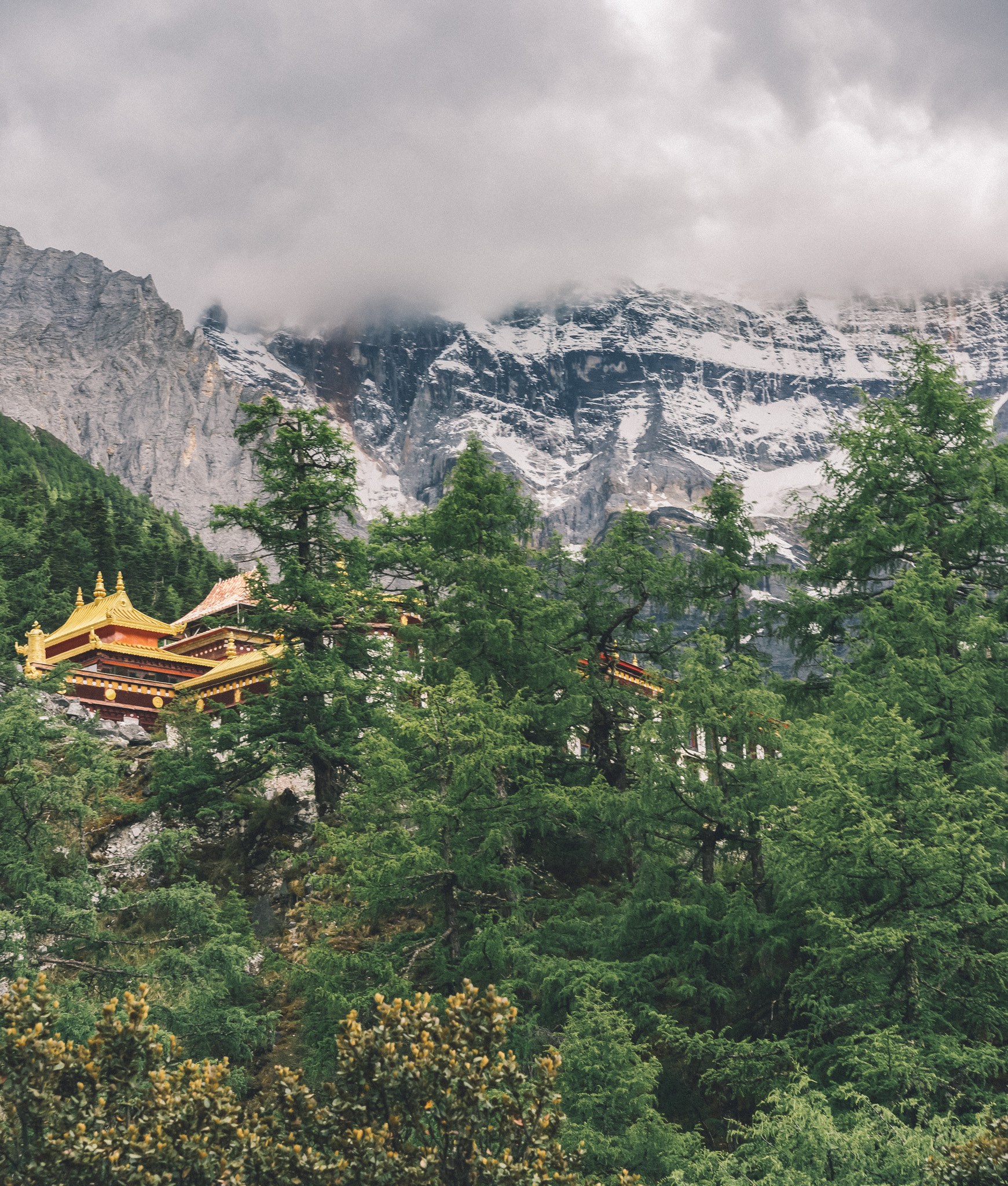
Why visit Yading?
Yading is still a pretty off-the-beaten-path travel destination in China, at least for foreigners. Travelling to Yading gives you a unique look at Tibetan culture, without the mandatory tour guide needed to visit the Tibetan Autonomous Region.
In 1928, American explorer Dr. Joseph Rock travelled throughout the region, taking photos to share with the outside world. His photos were published in the 1931 issue of National Geographic, giving people their first glimpse at the beauty of Yading.
There are quite a few different places that are referred to as the Shangri-La that James Hilton wrote about in his book Lost Horizon, but few are as plausible as Yading. It’s highly likely that Hilton based his Shangri-La off of the photos of Yading he saw in the National Geographic.
Tibetans have known about Yading for much longer – going back at least 800 years, Tibetans have considered the three peaks of Yading to be “above the gods”. Many Tibetans come from far away to complete a pilgrimage circuit around the peaks.
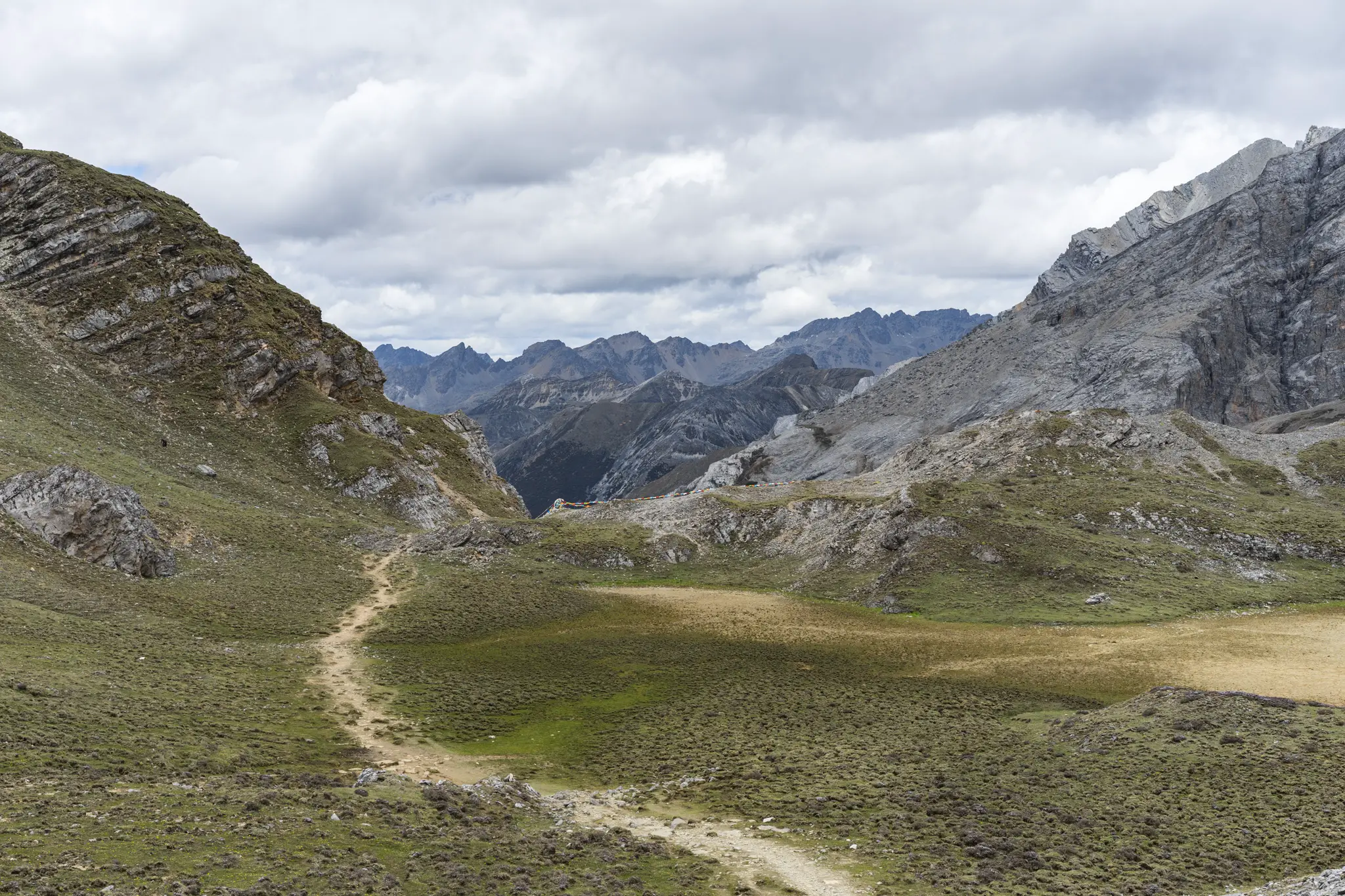
Getting to the Yading Nature Reserve
The Yading Nature Reserve is located in a pretty remote part of China. It’s in Western Sichuan, far from any large cities or high-speed rail routes. It’ll take a bit of work to get there, but it’s so worth it.
Flying to the Yading Nature Reserve
As of 2013, getting to Yading has become much easier with the opening of the Daocheng Yading airport, the world’s highest-altitude civilian airport. The airport has direct flights from Chengdu, Chongqing, Luzhou, and Xi’an.
Flights from Chengdu (CTU) to Daocheng (DCY) are around $90 or ¥630 one-way at the time of writing this. Prices are likely to be higher during peak season.
The best way to book domestic flights in China is by using Trip.com.
After flying to Daocheng, you still need to get to Riwa at the entrance of the Yading Nature Reserve. See below for more info on that.
Overland to the Yading Nature Reserve
If you’re feeling adventurous, you can take the overland route from Chengdu to Shangri-La (or vice-versa), and stop at Yading along the way.
The overland route through Western Sichuan is incredible, and I guarantee it will be one of your favourite travel experiences. It will take around 8 to 10 days to complete the overland route with a stop at the Yading Nature Reserve.
On the overland route, you’ll get to visit Tibetan monasteries, drive over high mountain passes, and experience authentic Tibetan culture that’s quite hard to come by nowadays.
Want to travel to the Yading Nature Reserve overland? Check out my post on the overland route from Chengdu to Shangri-La for more info.
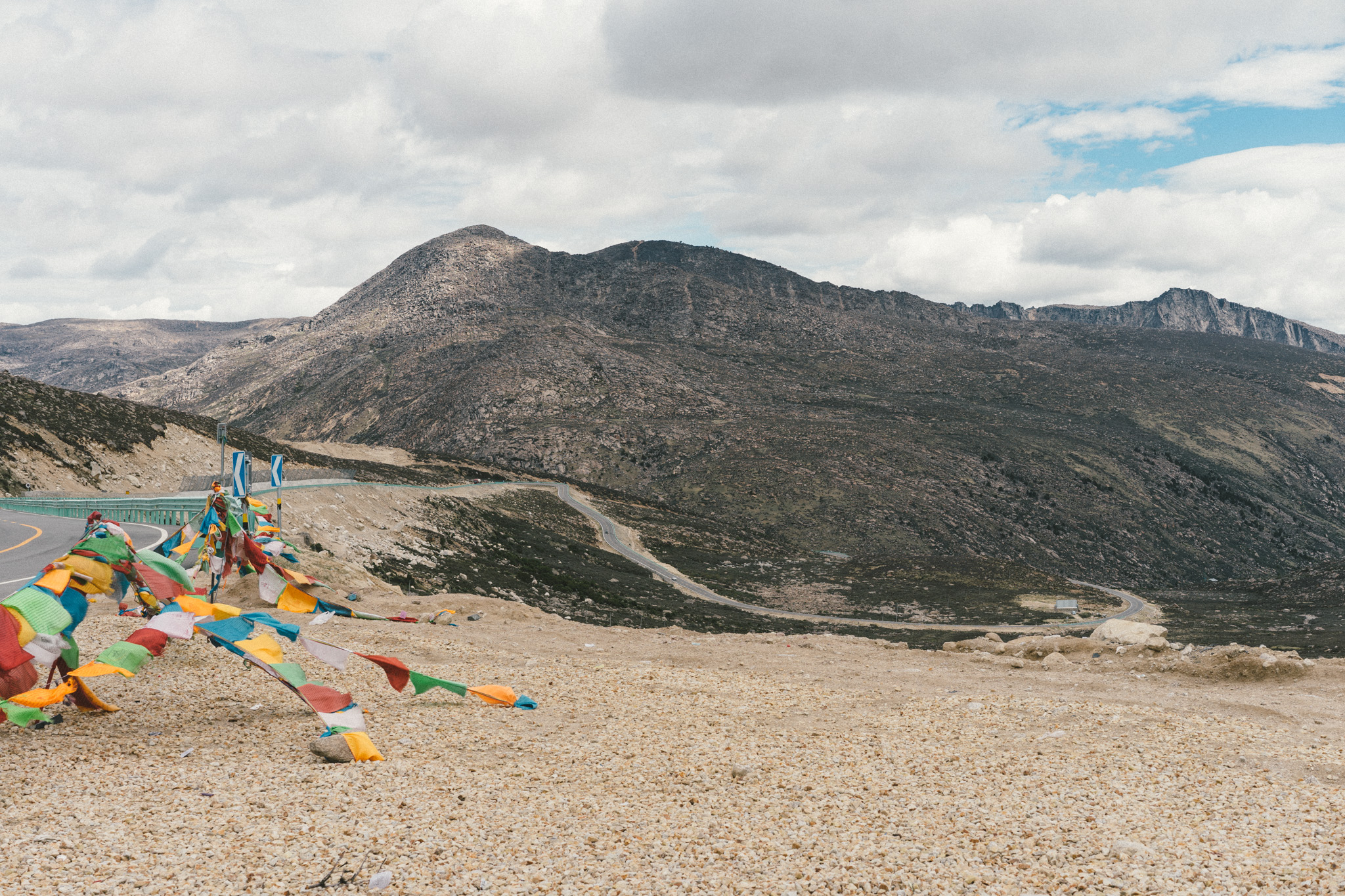
Getting to Riwa from Daocheng
After you arrive in Daocheng (via flight or overland route), you’ll need to get to Riwa. Riwa is a very small town located at the entrance area to the nature reserve.
From Daocheng, you can find buses and minivans that leave from near the bus station. Try to get there early – I had arrived in Daocheng quite late and had to wait five hours for my shared minivan to fill up. The journey from Daocheng to Riwa will take about 3 hours. It’s a gorgeous drive so try to get a window seat!
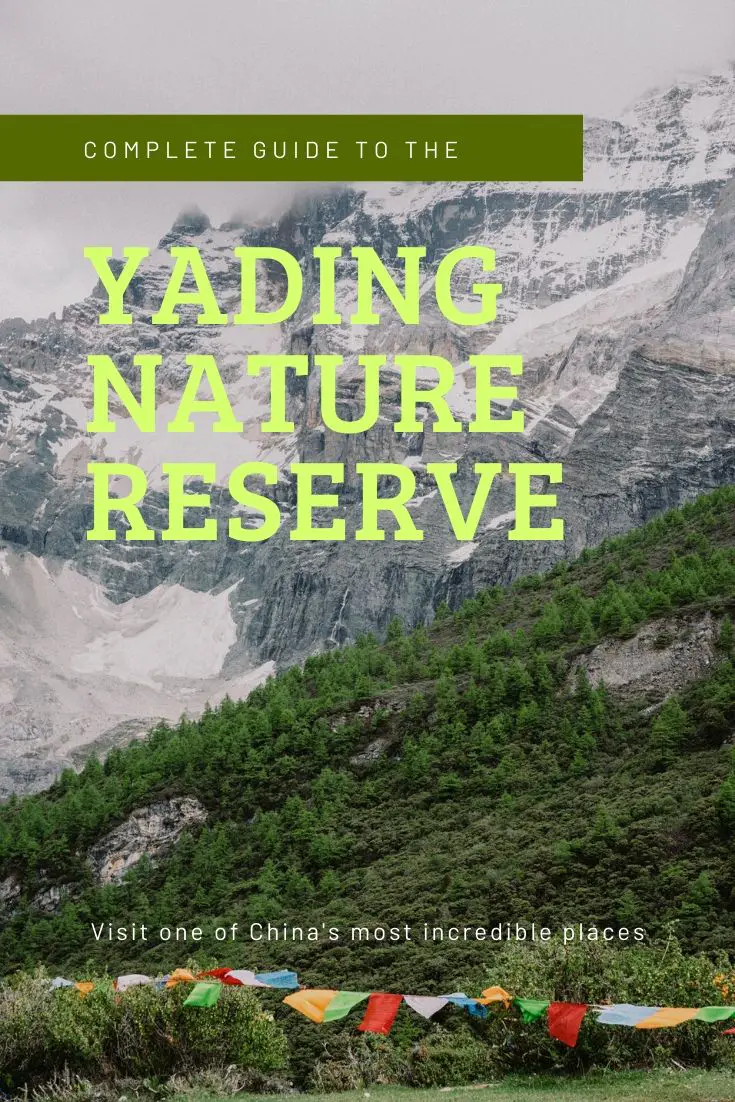
Yading Nature Reserve Map
It may be a bit confusing trying to visualize the layout of the Yading region, so I’ve put together a basic map to give you an overview. It marks Daocheng, Riwa, Yading Village, and the trekking route around Mt. Chenrezig.
I also recommend downloading MAPS.ME and downloading Sichuan Province for offline use. A number of hiking trails and other useful things in the nature reserve are marked.
Where to stay in Yading
If you’re going to be visiting the Yading Nature Reserve, you’ll most likely need accommodation in Daocheng, Riwa and/or Yading Village. Here are my recommendations for each different place:
Daocheng
Daocheng is a reasonably sized town with plenty of accommodation options.
If you’re on a budget, I’d recommend staying at either the Daocheng Fanhegu Hostel or Daocheng Time 1990. Both are cool Tibetan-style hostels that are very affordable.
Looking to splurge a bit? Check out the Sunshine Hot Spring Hotel.
Riwa
Riwa is smaller than Daocheng, and basically everything here caters towards tourists who are planning on visiting Yading.
There is a hostel in Riwa called the Ri Wa International Youth Hostel – it’s your best bet if you’re on a backpacker budget.
For a more private option, check out the Hongjingtian Hotel in Riwa.
Yading Village
This is the last place that you can find any sort of accommodation in Yading. There are a number of small basic hotels here, you should be able to just show up and get a room fairly easily.
Camping
When you’re inside the Yading Nature Reserve, you can camp anywhere after the pass just after Milk Lake. Don’t camp before here – there are lots of other people and camping isn’t exactly “allowed”.
After the pass, there’s nobody around other than the odd Tibetan shepherd that might come to say hi.

Entering the Yading Nature Reserve
From the main area of Riwa, the entrance to the Yading Nature Reserve is about two kilometres down the road. I walked there, but you could also take a taxi.
At the entrance area, you’ll need to pay the admission fee. The fee is ¥150 for admission, and ¥120 for the sightseeing bus. Unfortunately, the sightseeing bus is not optional, so you’ll end up paying a total of ¥270. The sightseeing bus takes you from the entrance area to the actual park, a 20-kilometre drive on windy mountain roads.
There is a very small town at the actual entrance to the reserve (near where the sightseeing bus will drop you). The town is known as Yading Village. There are hotels here, and it’s a good place to spend the night after hiking in the park during the day.
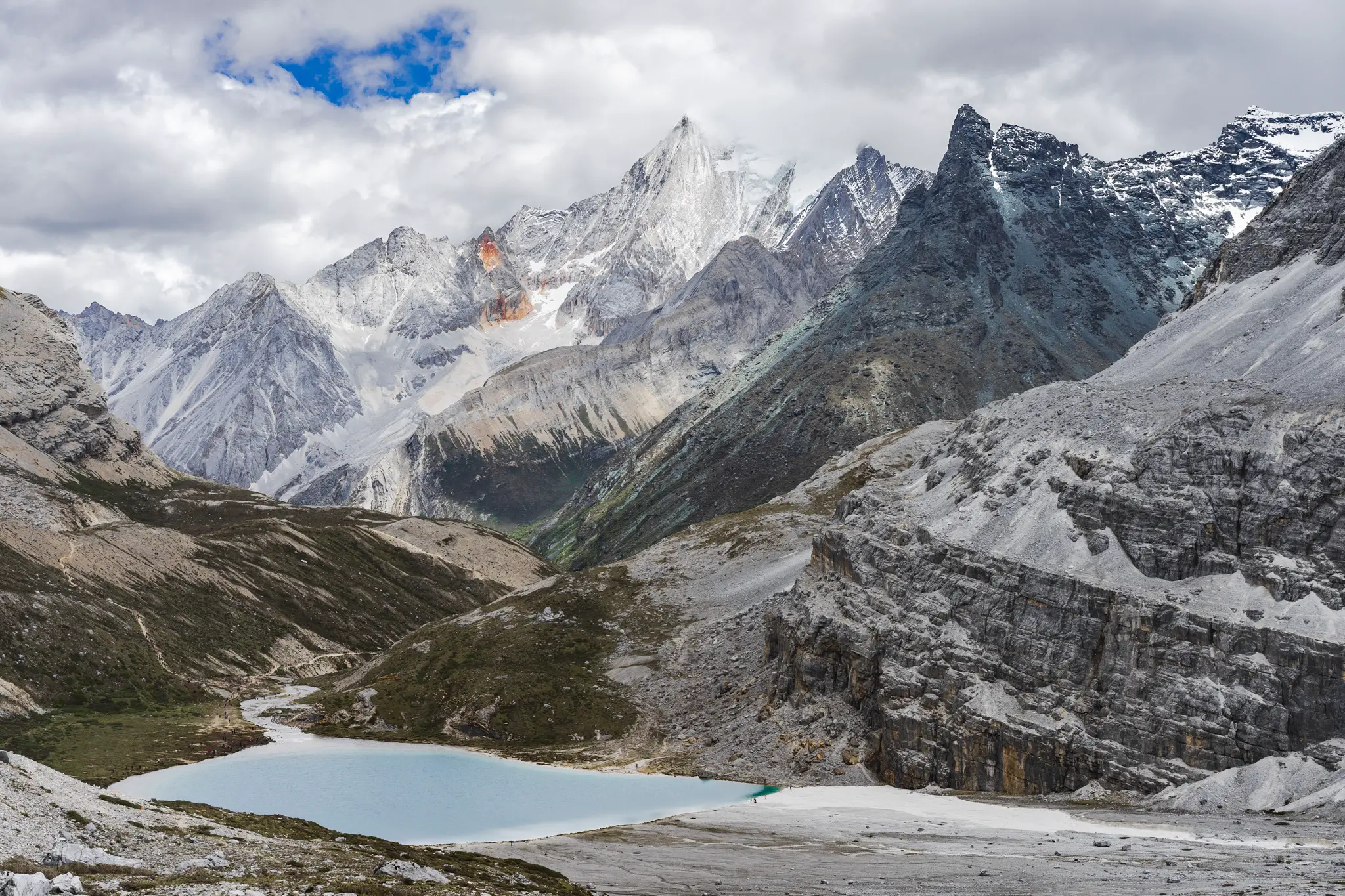
What to do in the Yading Nature Reserve
After taking the sightseeing bus into the nature reserve, you’ll be dropped off near the Chonggu Monastery. This area is where all the different paths around the nature reserve come together.
If you’re not planning on trekking around Mt. Chenrezig and just want to visit the main sights of the nature reserve, you will still start here. To get to the Luorong Grasslands from Chonggu Monastery without hiking, there are electric carts that transport tourists along a paved road. The electric cart costs ¥50 one-way or ¥80 round-trip, but unless you really need it, I’d recommend saving the money and walking this part. The views are great!
After exploring the Luorong Grasslands, you can either hike or ride a horse to Milk Lake. Horse rental is ¥300 for a round-trip ride.
To visit anywhere else in the Yading Nature Reserve, and get away from other tourists, you’ll need to do some hiking.
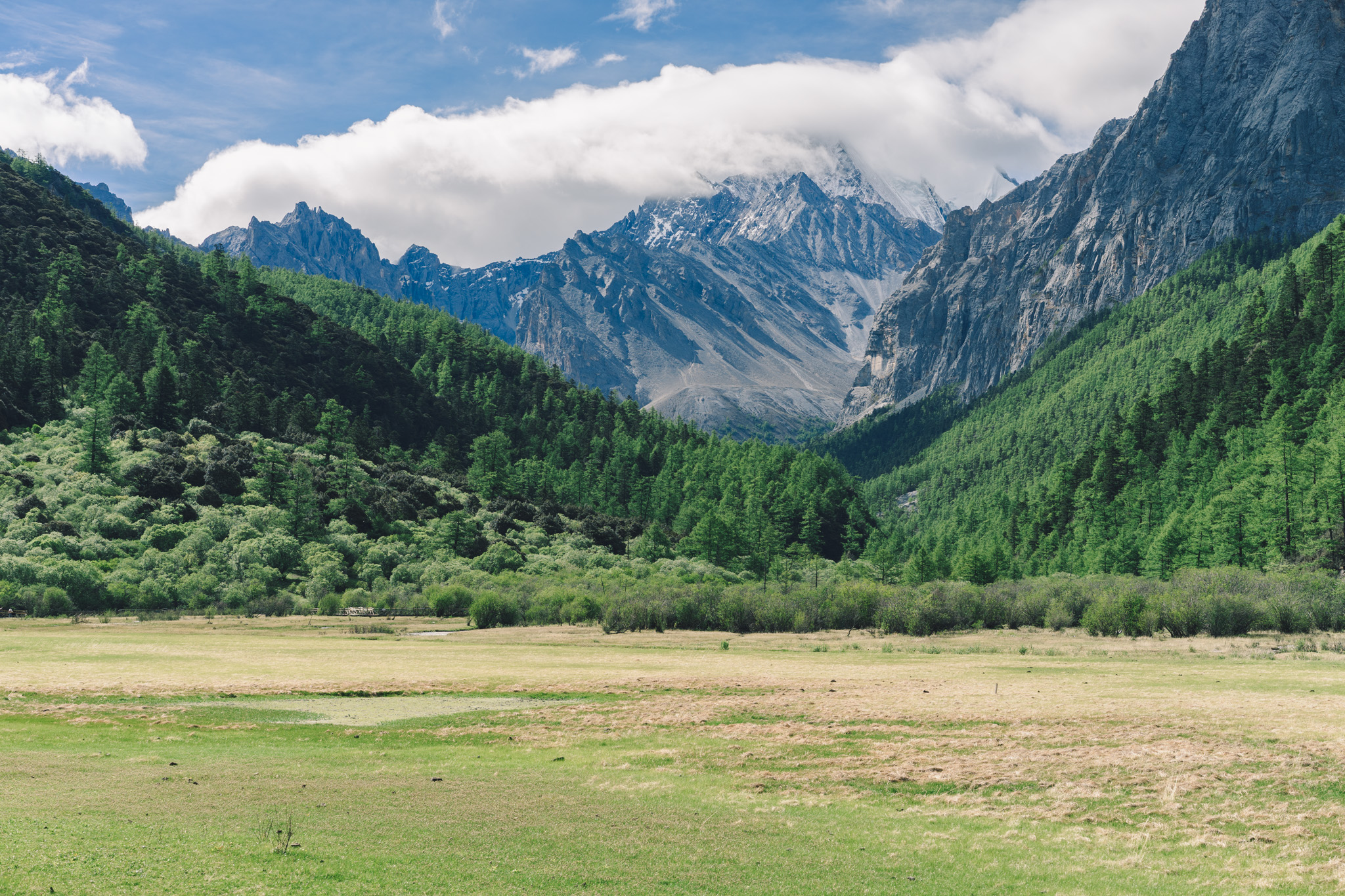
Mt. Chenrezig Kora Trekking
The most popular trek in the Yading Nature Reserve is the 1-2 day long pilgrimage circuit (kora) around Mt. Chenrezig. I did the trek in one day, but if you hike at a more relaxed pace I’d recommend taking two days.
Let’s go over the different stages of the kora around Mt. Chenrezig:
Stage 1 – Chonggu Monastery to the Luorong Grasslands
The first stage of the trek will take you towards the Luorong Grasslands. For this section, the pathway is either a paved road or a metal grid pathway through the woods.
The paved road is used by electric carts that shuffle domestic tourists to the grasslands, so I’d recommend walking on the pathway rather than the road.
From the Chonggu Monastery to the Luorong Grasslands it’s 6 kilometres of walking with an elevation gain of 180 meters. This stage shouldn’t take you longer than two hours.

Stage 2 – Luorong Grasslands to Milk Lake
The Luorong grasslands are at an elevation of around 4180 meters, so you’ll definitely be feeling the altitude unless you’re already acclimatized.
When walking through the grasslands, you’ll get amazing views of all three holy mountains in the nature reserve. There are a few Tibetan huts here, and the locals provide horse rides to the domestic tourists who don’t feel like walking to Milk Lake.
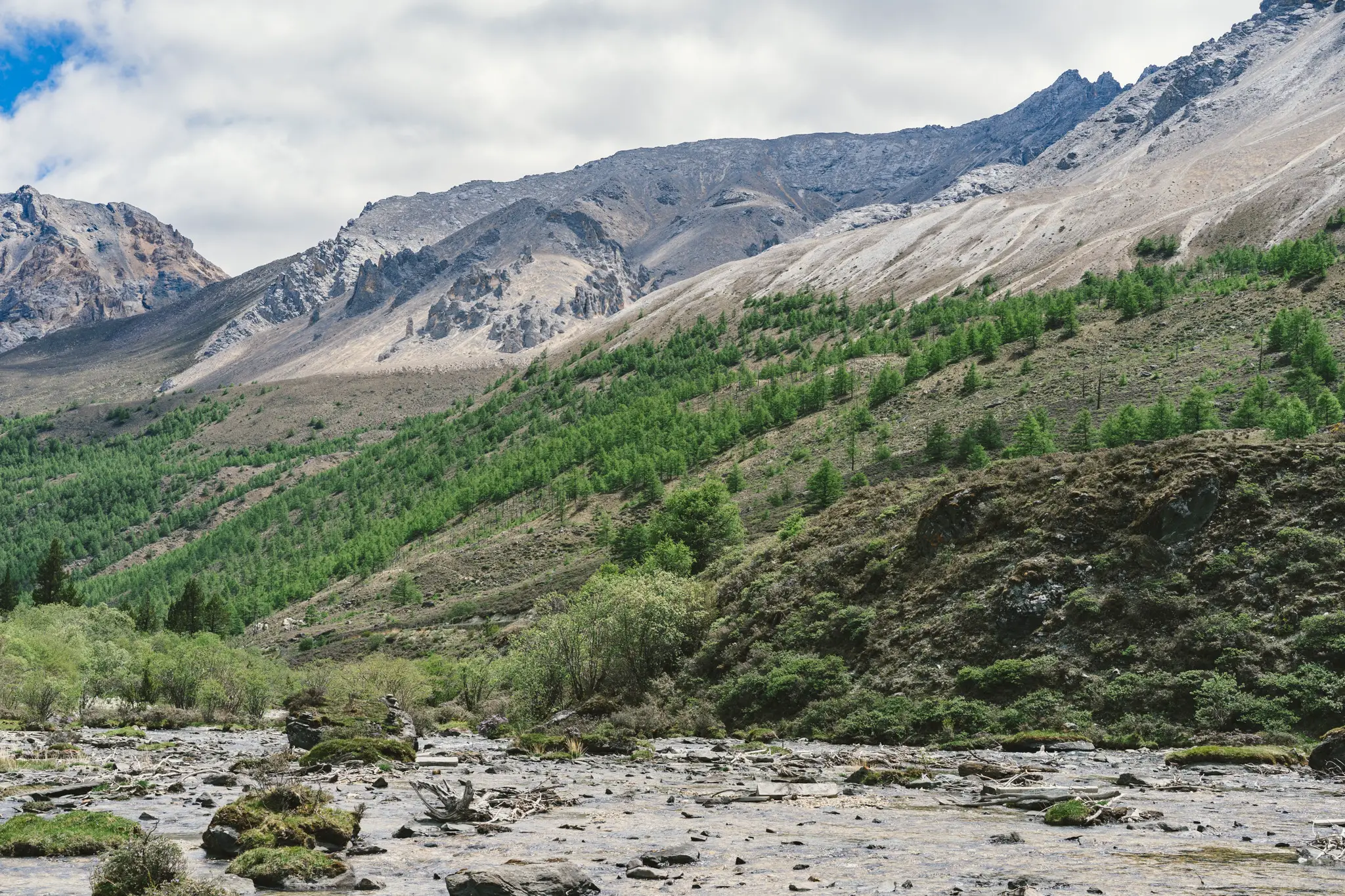
The pathway through the grasslands is a wooden boardwalk and is very easy to follow. After walking through the grasslands for a couple of hours, you’ll reach the end of the walkway and begin the steeper climb towards Milk Lake.
The ascent to Milk Lake is fairly steep and is a little unsafe due to the large numbers of domestic tourists who don’t really know what they’re doing.
From the Luorong Grasslands to Milk Lake, you’ll cover a distance of 5 kilometres and gain about 300 meters in elevation. Budget around two and a half hours for this stage.
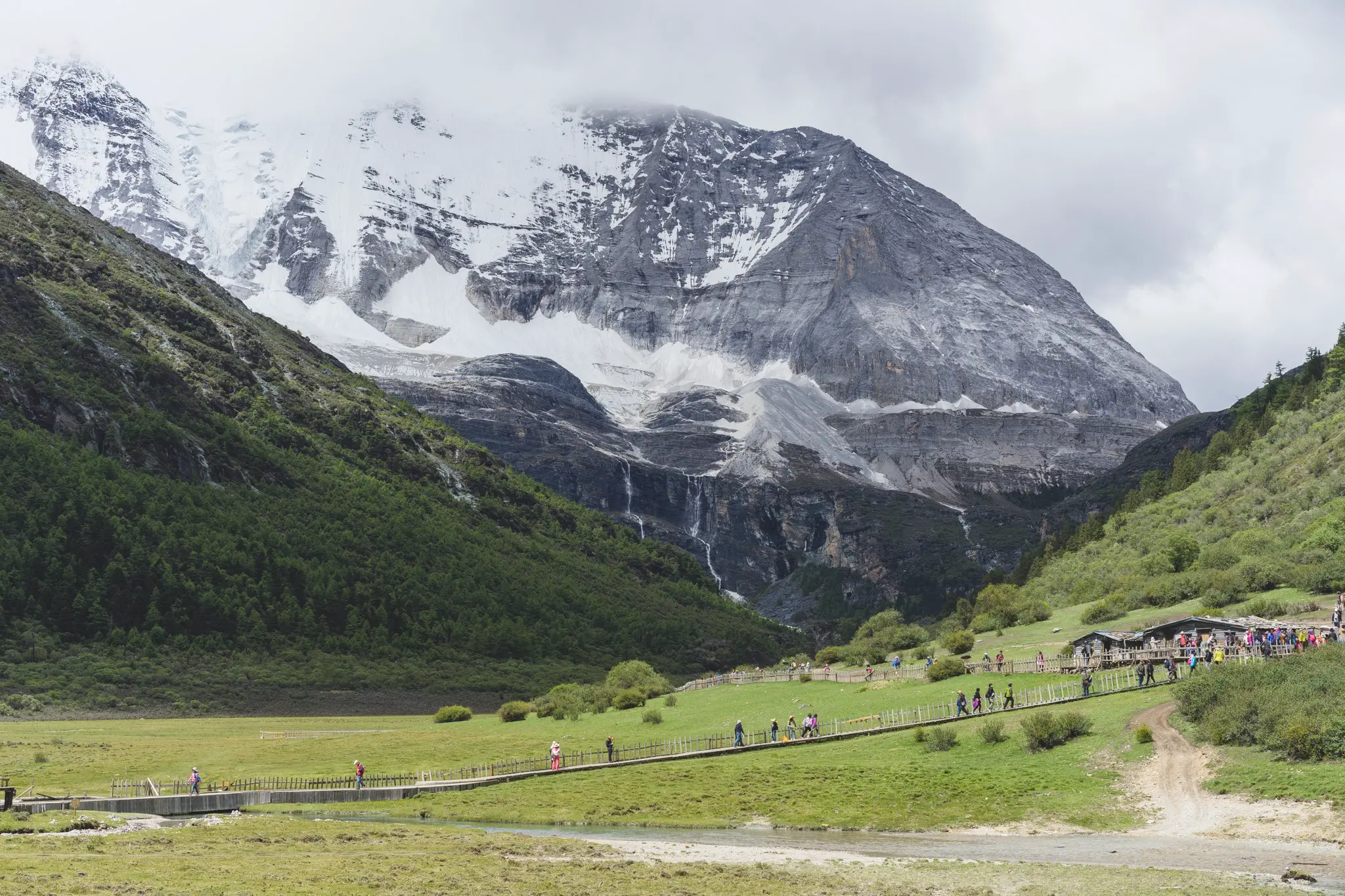
Stage 3 – Milk Lake to the First Col
Continuing past Milk Lake, you’ll now likely be alone on the trail (other than a few Tibetans completing the Mt. Chenrezig kora).
After taking in the sights at Milk Lake, your next goal is to cross the First Col at roughly 4,700 meters in elevation. The trail from Milk Lake to the First Col is well-defined. Keep Mt. Chenrezig on your right and you can’t get lost. Crossing the pass isn’t too difficult, and the top of the pass is covered in a ton of prayer flags.
From Milk Lake to the First Col, you’ll gain 250 meters in elevation and cover about 1.5 kilometres. This stage shouldn’t take longer than an hour.
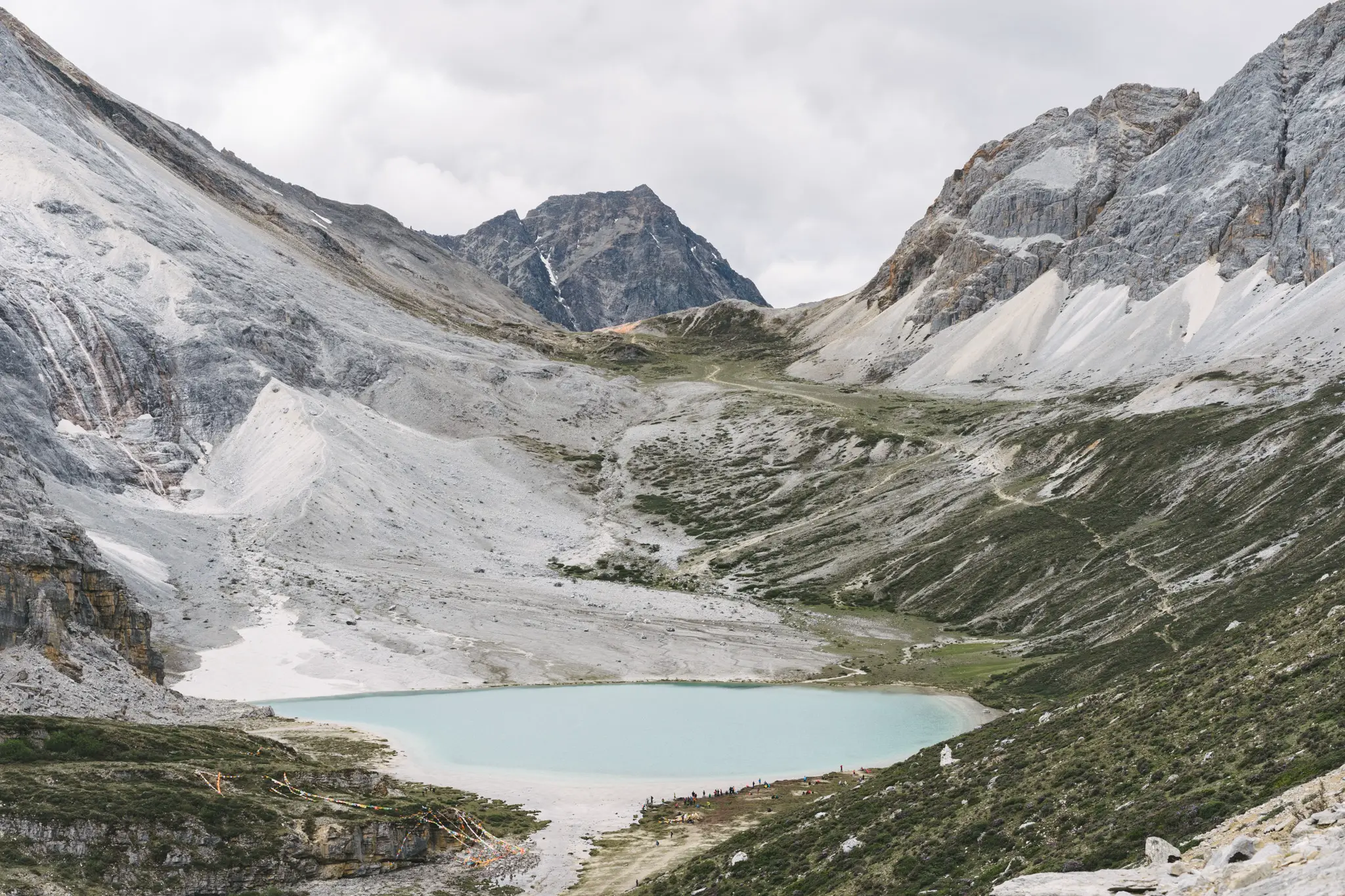
Stage 4 – First Col to the Second Col
A few hundred meters after crossing the First Col, you’ll come across a fork in the path. The fork is marked by a prayer wheel on a wooden pole.
Be sure to go right at this fork. If you go left, you’ll end up lost in another valley.
After going right at the fork, you’ll begin a descent into a meadow filled with lavender. In the meadow, you’ll see stone huts used by Tibetan shepherds.
If you’re camping, this is a perfect place to set up (You aren’t allowed to camp anywhere before the First Col). There are water sources nearby, and it’s in a bit of a valley to protect from strong winds.
Continuing on for an hour or so, you’ll descend a few hundred meters before beginning an ascent back up to the Second Col.
The trail here is still well-defined, just keep Mt. Chenrezig on your right and you won’t get lost.
From the First Col to the base of the Second Col, you’ll hike about 6 kilometres and lose about 350 meters in altitude. It should take a little less than two hours.
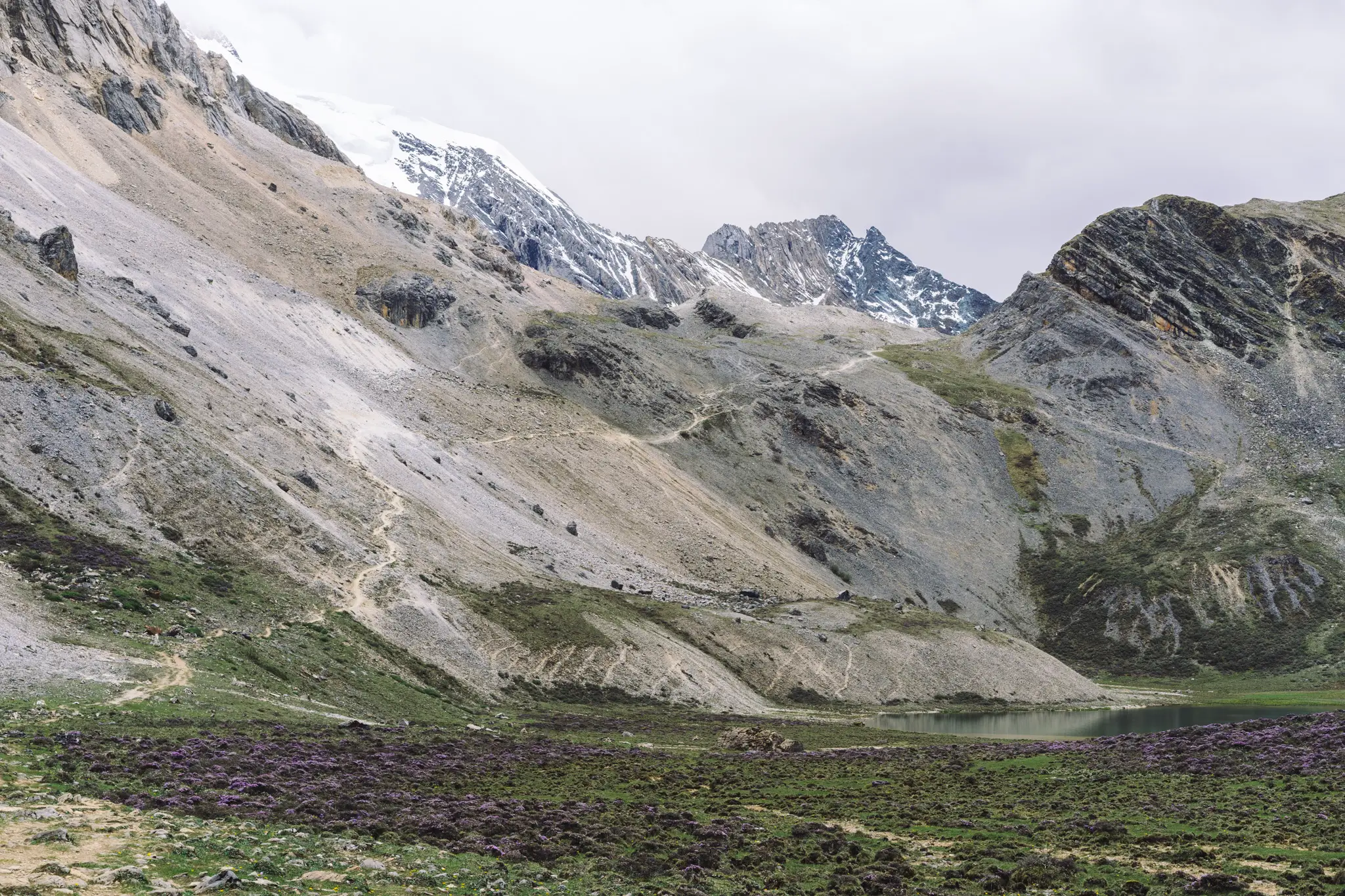
Stage 5 – Crossing the Second Col
After a bit of a walk from the lavender meadow past some more stone huts, you’ll get your first views of the Second Col (4,665 meters).
The climb to the top of the Second Col follows an obvious path but is definitely the toughest part of the trek. You’ll be quite tired at this point, so ascending back to 4,665 meters is difficult. Take plenty of breaks to enjoy the gorgeous views down into the tree-filled valleys far below you.
Take it slow, and soon enough you’ll be at the top of the Second Col. Like the First Col, thousands of Tibetan prayer flags mark this pass.
Crossing the Second Col will take about 1.5 hours.
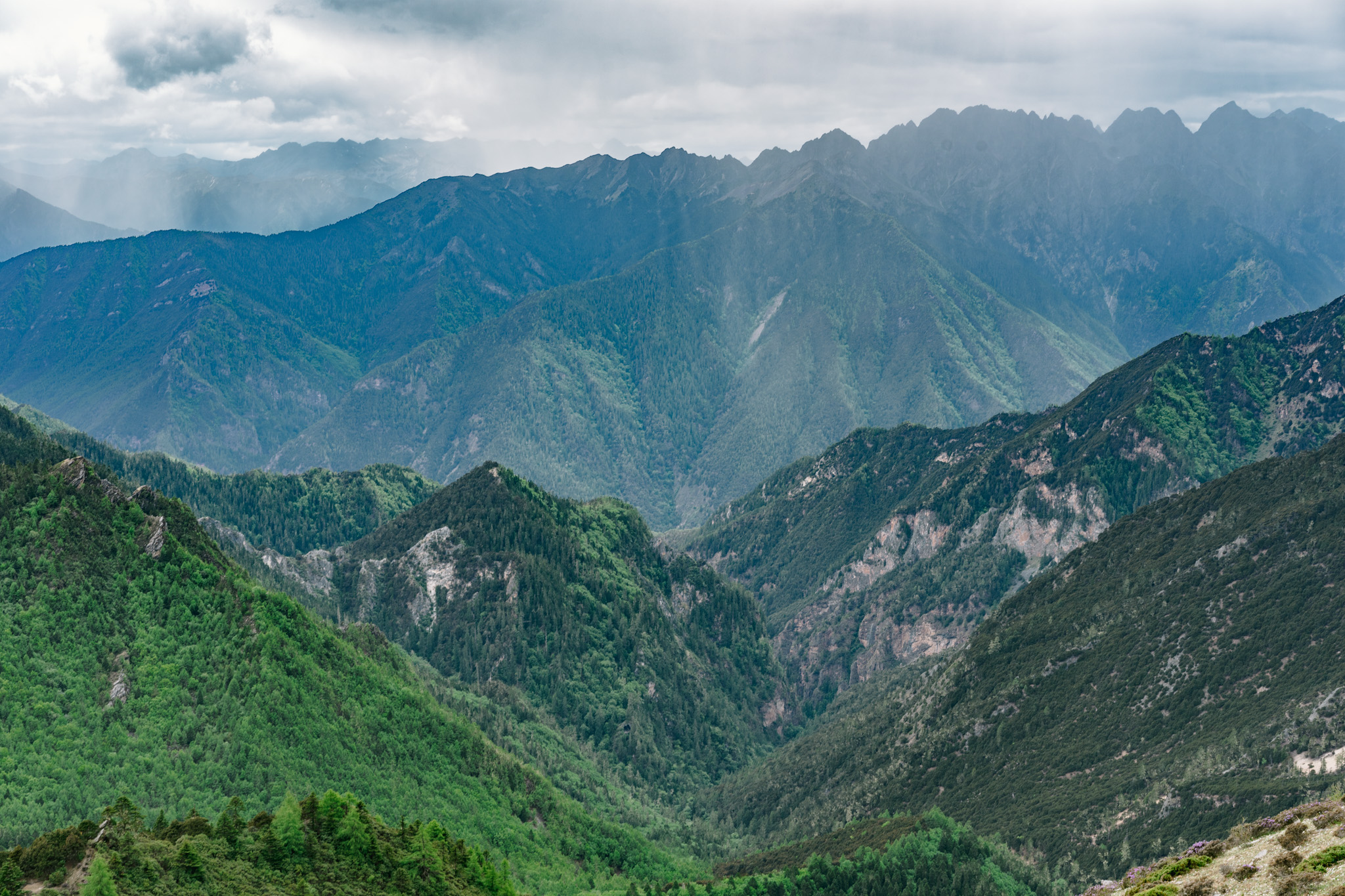
Stage 6 – Second Col to Pearl Lake
Descending from the Second Col to Pearl Lake is nice and easy. It’s all downhill from here, so the thicker air will make you feel nice and strong again.
Continue to follow the path and you’ll pass through a pine forest and eventually end up at Pearl Lake. Upon reaching Pearl Lake, you are now back in the “tourist zone” of Yading.
From the Second Col to Pearl Lake, you’ll cover about 3 kilometres in distance and descend about 500 meters.
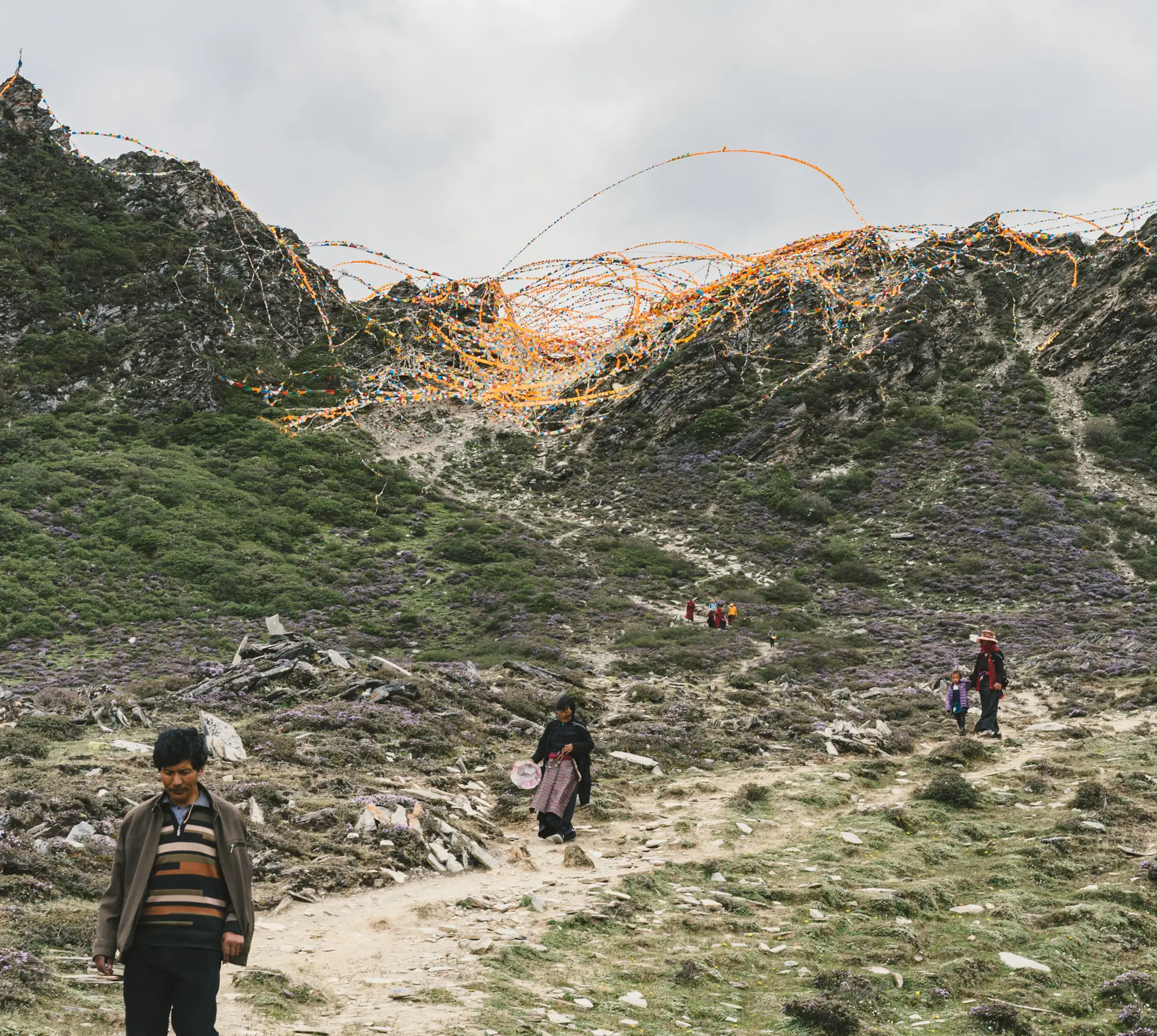
When you arrive at Pearl Lake, there are posted signs and maps that you can follow the rest of the way back to Chonggu Monastery. From Pearl Lake to Chonggu Monastery is another hour or so. From the Chonggu Monastery, catch the sightseeing bus back to either Yading Village or Riwa and relax after a successful trek!
Yading Nature Reserve Itinerary
Here are a few sample itineraries to give you some inspiration while planning your trip to the Yading Nature Reserve. These itineraries assume your starting point is in Daocheng.
3-Day Yading Nature Reserve Itinerary
Three days gives you enough time to visit the main areas of the Yading Nature Reserve, and even hike around Mt. Chenrezig if you’re a fit hiker.
- Day 1 – Travel from Daocheng to Riwa, and stay there for the night.
- Day 2 – Wake up early, and take the park bus into the nature reserve. From here, you can hike around Mt. Chenrezig, or simply visit the main sights such as Milk Lake and Chonggu Monastery. Sleep in Yading Village or head back to Riwa if you finished the day early enough.
- Day 3 – Head back to Daocheng from Riwa in the morning and you should be back in Daocheng by lunchtime.
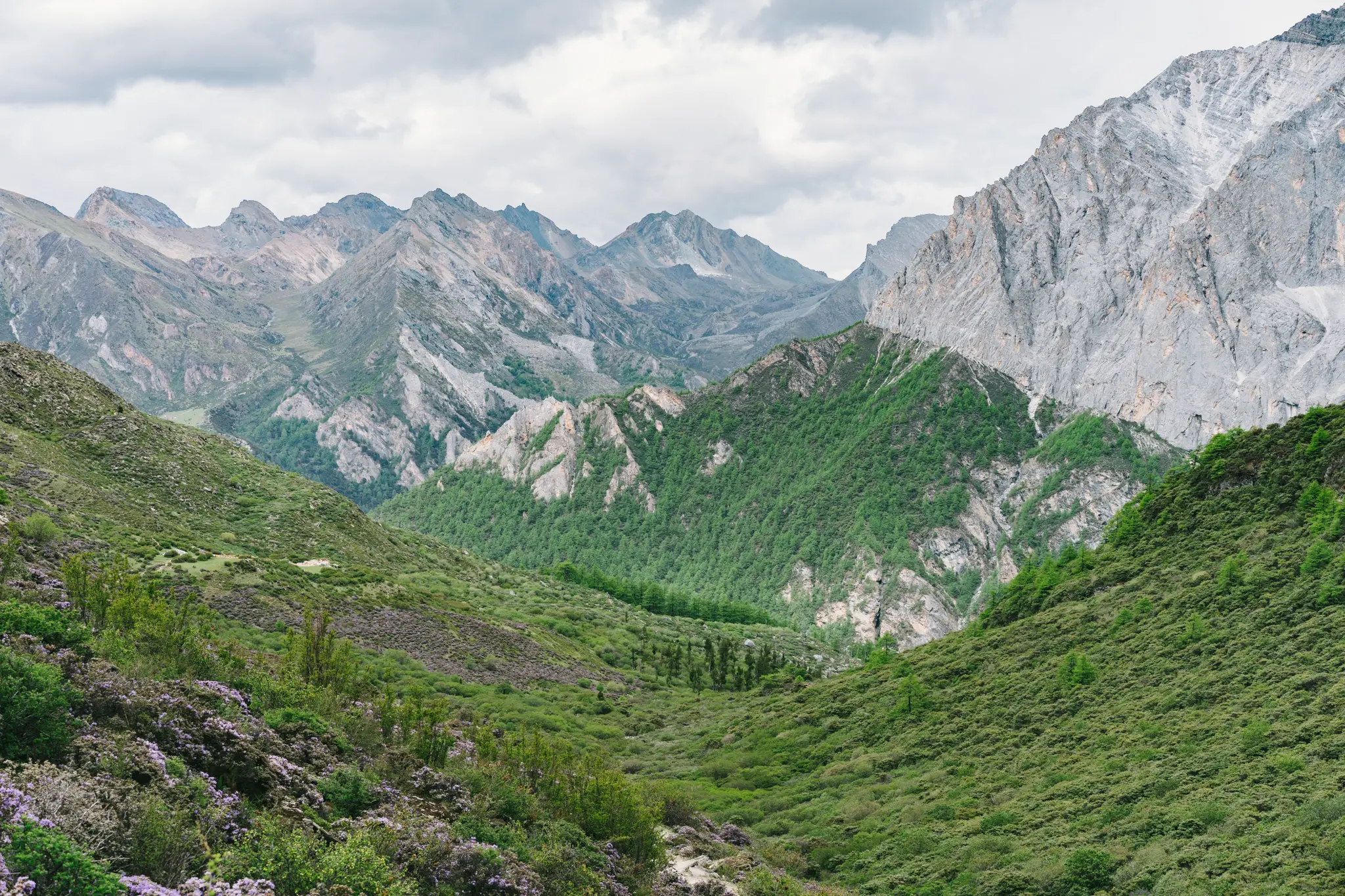
4-Day Yading Nature Reserve Itinerary
Four days is the perfect amount of time for an overnight hike in the Yading Nature Reserve if you’ve got camping equipment with you.
- Day 1 – Travel from Daocheng to Riwa, and stay there for the night.
- Day 2 – With an early start, take the park bus into the nature reserve. Begin hiking at a casual pace and set up camp somewhere over the First Col. Enjoy a beautiful sunset alone in the mountains.
- Day 3 – Complete your kora around Mt. Chenrezig – you’ll likely make it back to Riwa by mid-afternoon, and could overnight there.
- Day 4 – Head back to Daocheng from Riwa in the morning and you should be back in Daocheng by lunchtime.
If you’ve got even more time in the Yading Nature Reserve, consider doing the big kora around all three holy mountains.

When to visit the Yading Nature Reserve
The best time to visit the Yading Nature Reserve is in the fall (September and October). The trees will turn a golden-orange colour and the entire nature reserve will look incredible.
Spring (April and May) is also a good time to visit. The summer months get a lot more precipitation, but it’s still possible to visit.
In the winter, it will be cold but still beautiful. Trekking may not be possible at this time of year if the passes are covered with snow.
I visited in late June, and the weather was so-so. The day I trekked around Mt. Chenrezig it was cloudy, blocking some gorgeous views of the giant peaks around me. It’s best to have a day or two of flexibility in your itinerary in case of bad weather.
No matter when you visit, it’s important to be prepared for any sort of weather. Things can change quickly in the mountains, and a sunny day can turn terrible very fast. I recommend bringing layers – a down jacket and some sort of wind/rain shell are a good combo for the warmer months.

Yading Nature Reserve Tips
Here are a few tips to make your visit to the Yading Nature Reserve even better!
- Bring proper sun protection. At high altitude, the sun is a lot stronger and you’ll burn very easily. Trust me, I’ve made this mistake before. High SPF sunscreen and a wide-brimmed hat are both good ideas.
- Drink at least four litres of water a day. Drinking water helps you acclimatize much faster.
- Bring proper hiking clothes. While it may be warm at the Chonggu Monastery, it can be much colder up by Milk Lake.
- Talk to the Tibetan pilgrims! At the base of the Second Col, some Tibetans invited me to have lunch with them. They were very surprised to see a foreigner doing the Mt. Chenrezig kora 🙂
- There are longer treks you can do in the region, but they require more logistical planning.
- The best place to get camping gear nearby is Kangding or Chengdu. Don’t show up in Yading Village expecting to be able to rent a tent. I’ve heard there are a couple of shops in Daocheng, but these may be difficult to find if you don’t speak Chinese.
- Start hiking early. In the mountains, the weather is usually best in the morning before clouds begin to form in the afternoon.
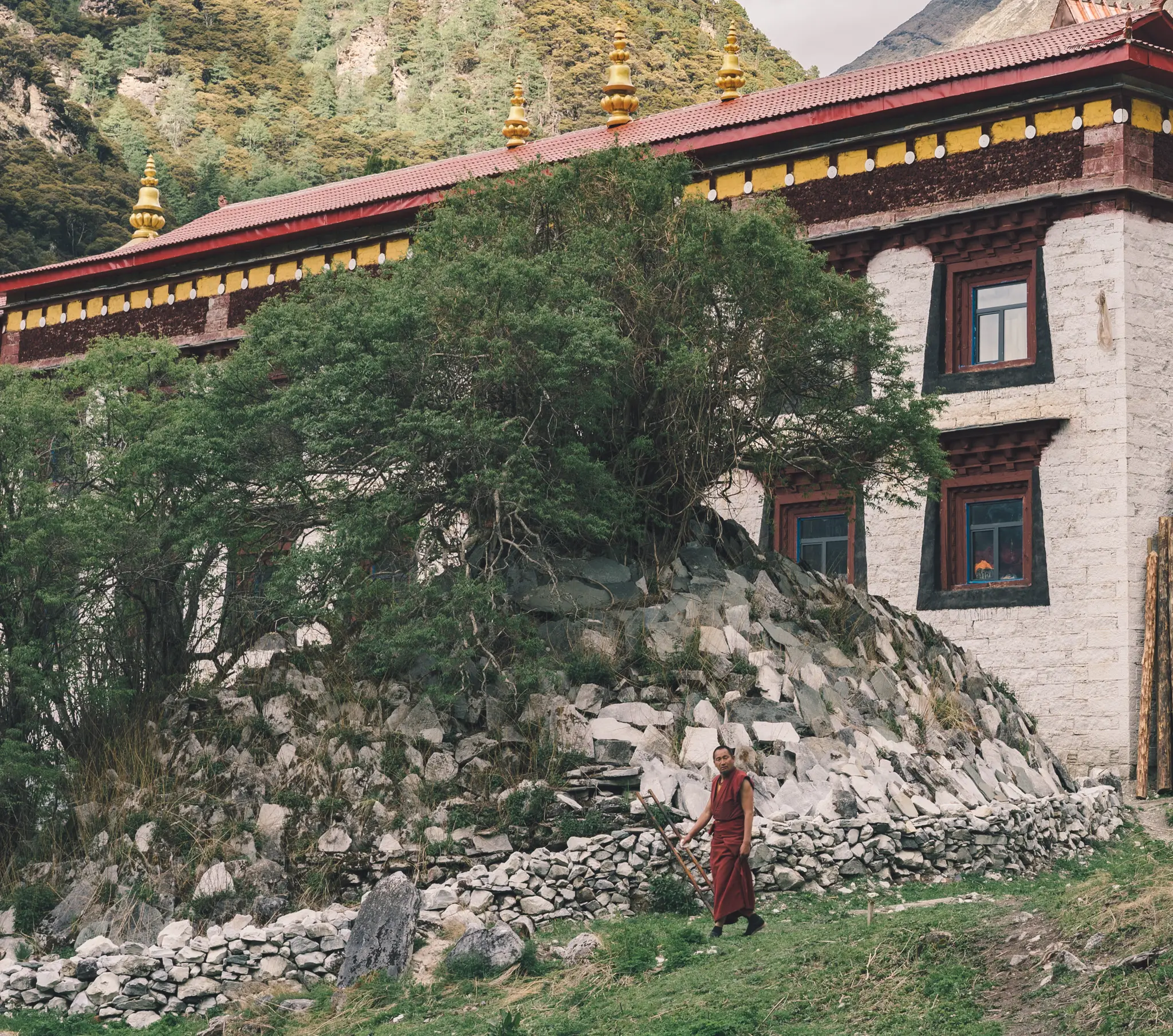
Yading Nature Reserve Wrap-Up
I hope this guide to travelling and trekking in the Yading Nature Reserve has helped you plan your trip!
If you’re on edge about visiting Yading, just take my word for it and go. It’s a gorgeous place that’s only going to get more and more popular as the years go on.
If you’ve got any questions, feel free to ask!
Planning a backpacking trip around China? Check out my comprehensive guide to backpacking China for everything you need to know!
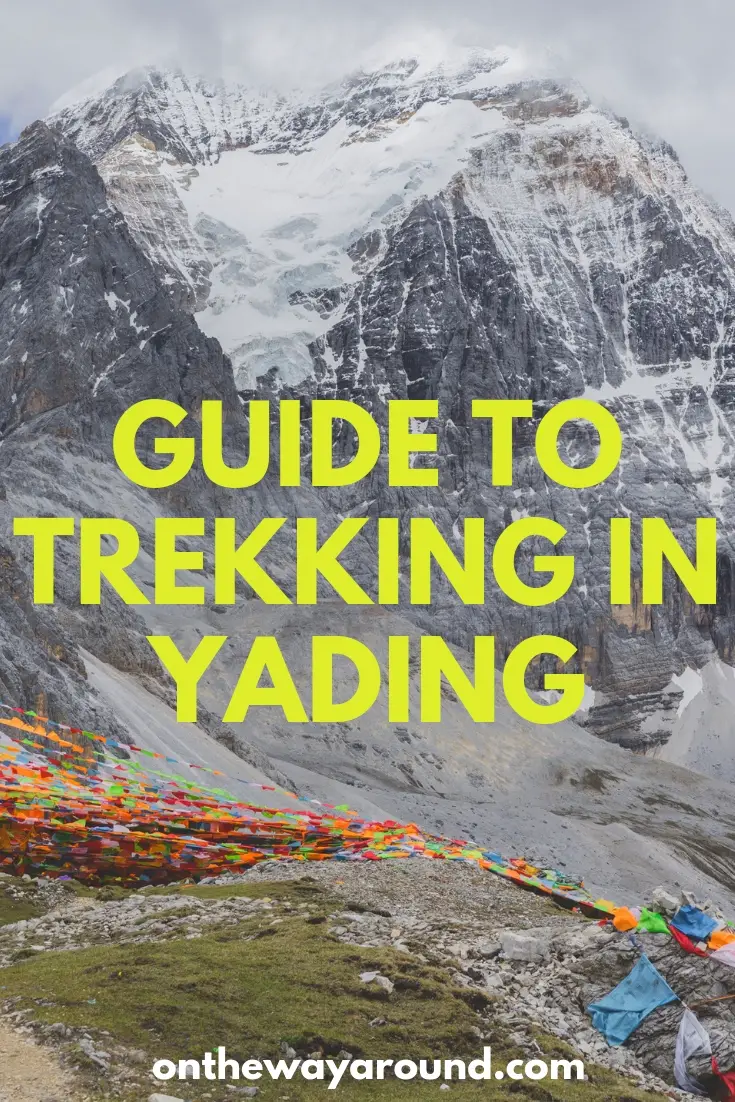

21-year old Canadian dude who loves to visit off-the-beaten-path places, climb tall mountains, and try delicious foods.
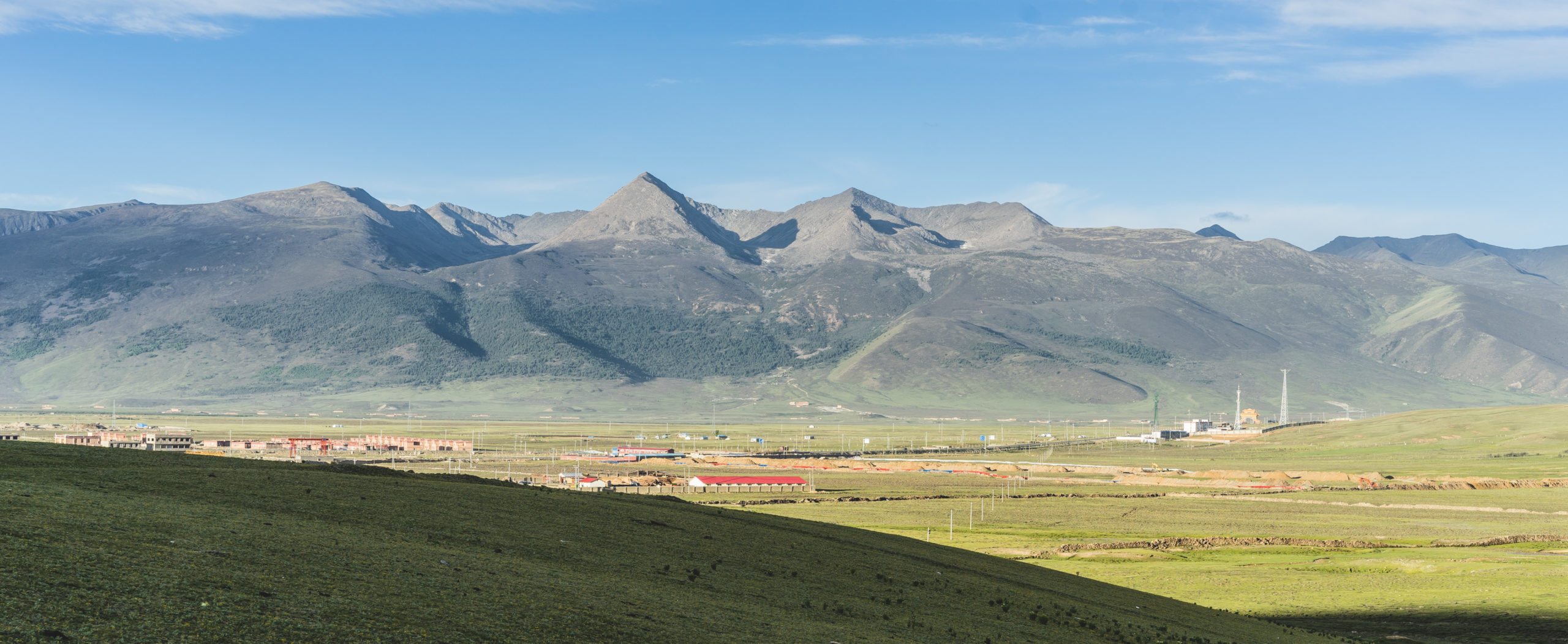
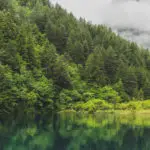
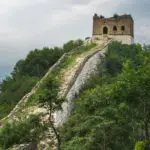
Hi Jacob, i feel lucky that google lead me to your site, here’s really awesome! we are planning a trip to Yading this coming May, and i’m still wandering around piece & bit of information about the area. i wanna ask your advice on entering the Yading Nature Reserve, is it compulsory to purchase the “sightseeing” bus tickets on top of the entrance fee? and if it’s possible we can walk from Riwa all the way to Luorong Grasslands? that’s because we wanna do some easy trekking as acclimatization. Or if you know anywhere out of the reserve area where we could walk up to a certain height, say above 3500m? ‘m still struggling to get a map of the Riwa-Yading area so far.
Many many thanks,
Ethan from Hong Kong
Hey Ethan, glad you like the site!
As far as I know, the sightseeing bus is compulsory. It’s a 37-kilometre drive from Riwa to Yading Village, and it would be pretty unsafe if they let people walk along the windy road.
Are you flying into Daocheng? If you spend a day or two in Daocheng, you’ll get a good base level of acclimatization as it’s at 3700m. Just drink plenty of water and get lots of sleep.
Another way to get some more acclimatization before trekking in the reserve would be a night at Yading Village – it’s also at around 3700m, and has great views of the holy mountains in the park.
If you spend some time in Daocheng and Yading village, you should be acclimatized enough to cross the high passes with no issues.
Here is a map I found of the area – on it, you can see Riwa, the 37km road, and Yading village.
Hope this helps! Let me know if you’ve got any other questions 🙂
thanks a lot Jacob! we will have a read into that and possibly we should do some acclimatization at Daocheng as we have already booked our hotel in Riwa~!
Cheers,
Ethan
Wow great guide! Thanks for the content 🙂
Thanks! Glad you liked it 🙂
Hi Jacob! I really enjoy reading your blog posts! Being inspired by the overland route from Shangri-la to Chengdu I am considering to go on a 4-week trip to Yunnan and Sichuan this summer and of course would want to include Yading in the itinerary. Since I would have to camp midway to do the multi-day trek, is there anywhere around Yading I could buy camping gear? Where did you get yours?
Thanks in advance!
Benjamin
Hey Benjamin!
As far as I know, there isn’t anywhere that sells or rents camping gear in Yading/Riwa.
I did the Mt. Chenrezig kora in a single day, so I didn’t bother with camping gear (I would’ve liked to spend more time trekking/camping in the area, but alas I didn’t have any gear).
If you’re starting in Shangri-La, I’d guess there’s a good chance you could get gear there but I don’t for sure.
There are definitely places to get gear in Chengdu and Kangding if you’re coming from the other direction.
Hope this helps a bit! Sorry I don’t know too much about getting gear in Yunnan.
Hi! Thanks for the info 🙂 Definitely helps. Guess I should consider doing the kora in a single day too!
Hey, Jacob! great content — Looking forward to your next post 😀 😀 😀
Hi! I’m solo traveler and planning to get bus from Shangri-la (Zhongdian) to Daocheng and spend 2days in Yading naiture reserve, then move to Daocheng Airport following day (my flight time is 10:30am to Xining by Sichuan Airlines).
It would be appreciated if anybody could advise following questiones:-
1. Ticket & shuttle bus for Yading naiture reserve: Though still not sure whether staying 3nights at Shangrila (Riwa) town or stay 1night at Yading village, Can use same ticket for 2-3days in eather case and only required to purchase the shuttle bus ticket twice in the event of staying Riwa town whole nights?
2. Is suitable shuttle bus to the airport available from both of Shangrila (Riwa) town and Yading village? (Flight time 10:30am)
Thanks in advance!
Hey,
Did this trek in 2017 in Fall. Just wanna say it was magnificent. I would recommend it hands down.
Cheers,
Thank you for the awesome write up! What did you do for your water supply while hiking? Is there access to streams that could be filtered or did you carry it all?
When I was there, there were a few streams along the way. I usually carry two liters and fill up when I find a source. I don’t recall having any issues finding water in Yading 🙂
Hi, I will be in Garze at the end of August, I was planning to first go to Kangding then Litang and finally Daocheng and camp in Yading.. well I have 10 days so my plan was to stay 2/3 days in each spot.
What do you think is it better to go from kanding to daocheng first and then litang?
I was wandering for the camping gear, and I read you said you can’t find it close to yading.
Are you doing a round-trip from Chengdu?
I’d probably recommend going Kangding-Litang-Daocheng-Yading. Litang is a bit over 4000 meters, making it a great place to help you get acclimatized for trekking in the Yading Nature Reserve.
You should try to get any camping gear you’ll need in Chengdu. It may be possible in Kangding, but I’m not certain. Try asking Zhilam Hostel if it’s possible in Kangding. Let me know!
Hi,
Thank you very much for sharing your experience, it is of great help for me.
I’m planning to go here by public bus but I cannot speak any Chinese. Would it be a problem to buy the bus tickets from Daocheng to Riwa?
Glad to help! You shouldn’t have any problems buying the bus tickets in Daocheng, just say Riwa and they’ll print you your ticket. Worst case, pull out the translator. People here are very kind and helpful, so you’ll be okay.
Amazing!! I have been looking for more information on trekking the kora before I head on over at the beginning of November so thanks for sharing your experience!
I just wanted to ask how long it took you to complete the trek in one day (did you leave early and arrive back late?), did you feel rushed doing it this way?
I would like to camp for the night and continue but we are heading to other places in China before/after where we won’t camp so don’t know if it is worth lugging camping gear around just for one or two nights…
but we ideally want to do all 3 peaks (maybe 1 peak a day and camp in between). I’m still researching more information on these longer treks.
Also lastly, is two days enough to acclimatize in Shangri-La/Daocheng before doing the kora? Or 2 night is Shangri-La and 1 night at higher elevation even?
Sorry for all the questions, always handy to get as much information and again, thank you so much for sharing and making it easier for the rest of us!!!
Hey Sneha! Glad to hear that the info I’ve shared is helpful 🙂
I actually had a bit of a late start when I did the trek, I didn’t get going until around 10 AM. And even with the late start, I still made it back to the starting point a few hours before sunset. I’ll note that I am a pretty fast trekker – but I think this trek is doable in a day for anyone who’s in decent shape. I’d just recommend that you start earlier, by 8 AM would be perfect.
If you do the trek in two days, your pace will be quite a bit slower carrying a bunch of camping gear at high altitude. But, if you want to explore more of the park than just the single mountain Kora, you will need to camp.
Regarding altitude, do you have any previous experience above 4000 meters? For me, one night in Shangri-La and one night in Daocheng would be ok, but everybody is different. Just drink lots of water, and listen to your body. I think going Shangri-La -> Daocheng -> Yading Village (near start of trek) -> Trekking Day is a good ideal acclimatization plan.
Hope this helps! Let me know if you’ve got any other questions.
Hi Jacob,
First of all, thanks a lot for your blog, I really appreciate all the details you gave about your itinerary in Sichuan as I am going to do the same starting from tomorrow! (taking the bus from Chengdu to Kangding) 🙂
About the Mt. Chenrezig trek route you proposed, if I want to do it in 2 days, do you think it is possible to to find an accommodation on the way ? I guess it will be a bit too cold to camp at this season as I don’t have very warm clothes…
Thank you for your recommendations!
Hey Aude,
Glad to hear you’re heading to Western Sichuan! You’ll love it.
Regarding the Mt. Chenrezig trek, I wouldn’t count on finding any sort of accommodation on the way. When I did the trek, there was nothing but nature the entire way past Milk Lake.
It likely will be pretty cold, and there’s a chance that the passes could be snow-covered. I’d suggest getting warm enough clothes – you don’t want to be alone at 4,500 meters in November without them.
Hope you have a great time! Let me know if you’ve got any more questions.
Hi jacob
Thank you for your information.
But I have a question. I want to camp at the first stone hut. Do I have to contact the staff first?🙂
As far as I know, you don’t. There’s no staff at the actual hut, and nobody will really know that you’re there.